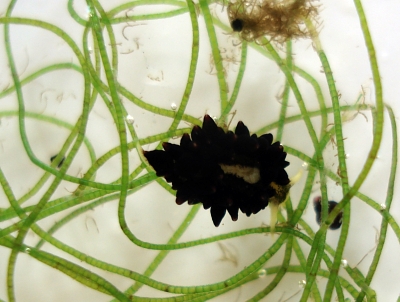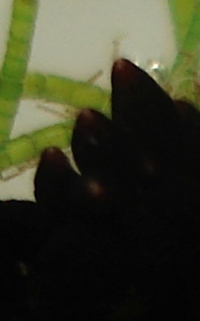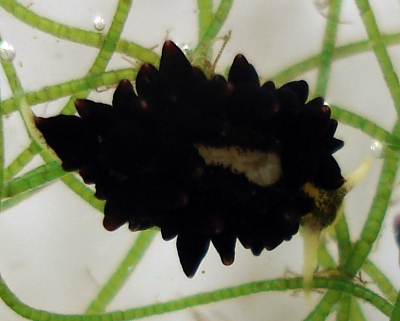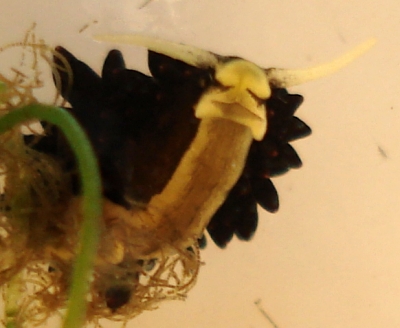Re: Calliopaea bellula - Ercolania cf. viridis & eggs
April 1, 2009
From: Kathe R. Jensen

Concerning message #22366:
Dear Bill and Marina,
I was surprised to see the dark variety of Ercolania viridis [= E. funerea]. This gives me an opportunity to share some pictures I took of Ercolania nigra from northern Kattegat during a student field trip in September 2006. I only had my pocket camera, so magnification is not very good. However, the ventral shot shows the pigmented band on the foot sole, which occurs in most specimens and which I cannot see in Marina's specimens nor in the photos from the Black Sea.
Locality: northern Kattegat, 0.5m, Denmark, NE Atlantic, 15 September 2006, sheltered sand flat with lots of drift Chaetomorpha. Length: approx. 3-4 mm. Photographer: Kathe R. Jensen.
Marina, if you have a chance of preserving a few specimens of both Ercolania viridis and Calliopaea bellula, I would be very grateful. I need specimens of C. bellula for comparison with C. oophaga to establish the synonymy.
Thanks in advance,
Kathe
krjensen@snm.ku.dk



Thanks Kathe,
Its good to get some photos of north Atlantic animals which match Lemche's E. nigra. Is it just a trick of the light in your photos or can I see an orange tip to the cerata, which would make them identical to the animals from the Mediterranean that you previously identified as Ercolania viridis [= E. funerea] [see message #8315]?
The other problem is that you seem to have missed my comment that it seems Marina's species [green and black forms] is different from the earlier Mediterranean animals which were identified as Ercolania viridis, both in general colour and in shape of the egg mass. In Marina's species the cerata have a whitish tip and whitish pustules all over them while in the 'other species' there is an orange tip to the cerata and no sign of whitish pustules. You can see the extremely different egg masses between Marina's species (with small sausage-shaped masses with relatively few eggs), and the orange-tipped species with a large sinuous flattened egg ribbon with many eggs.
If your northern species doesn't have orange tips it still means that there appear to be two species in the Mediterranean. I would appreciate your comments.
Best wishes,
Bill Rudman
Related messages
-
Information on Ercolania nigra
From: Bill Rudman, November 9, 2002
